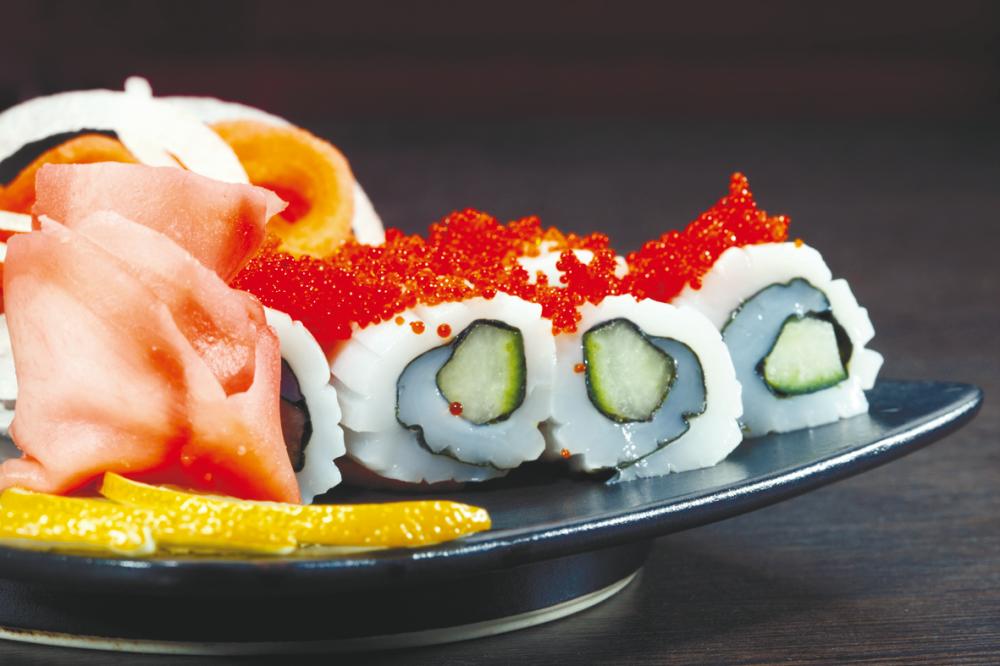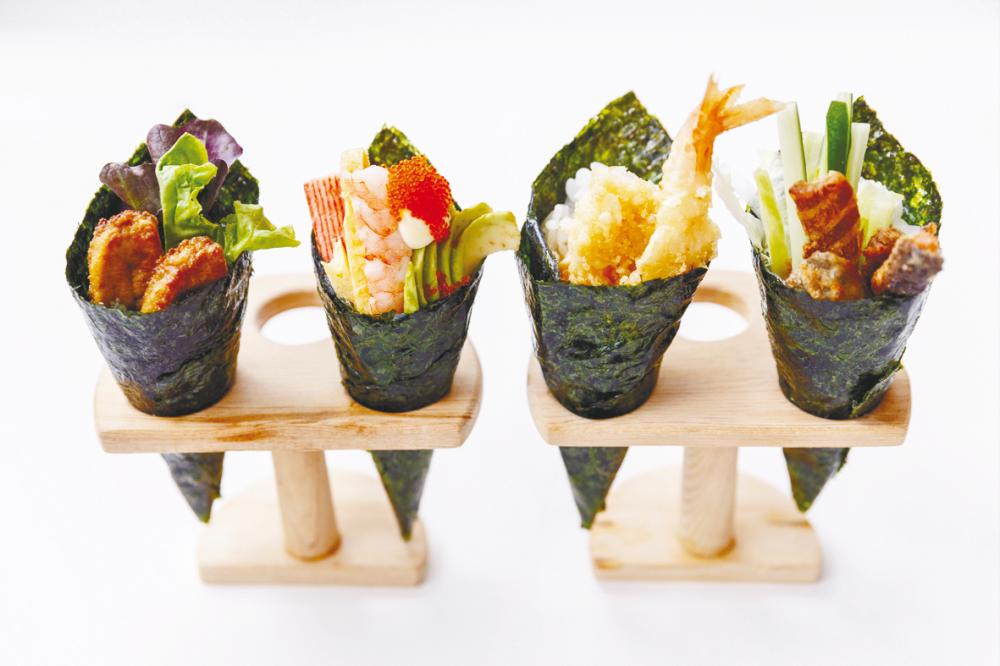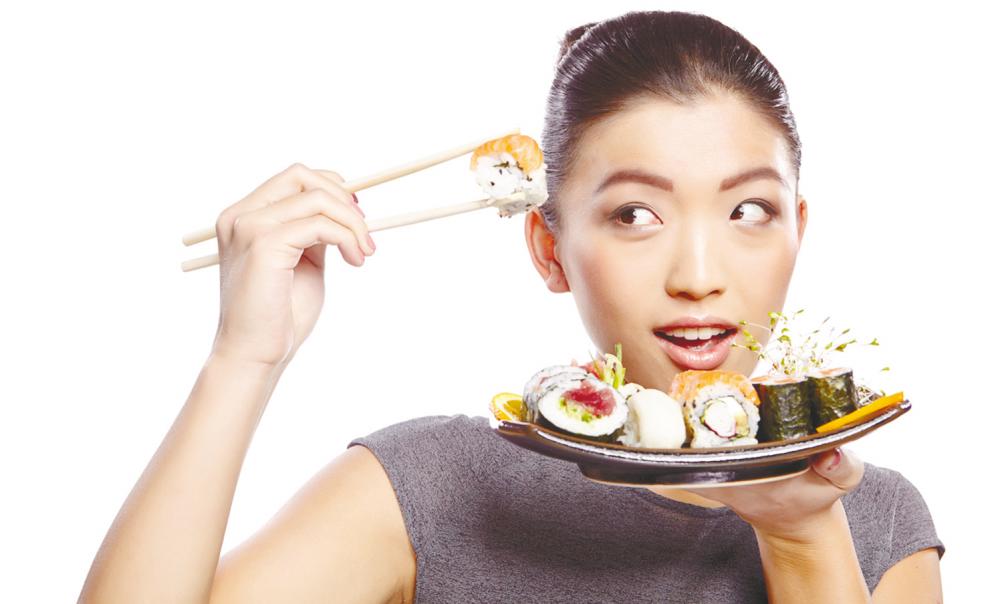This article was first published in theSun Buzz Sushi & Shows edition. So yes, you can enjoy watching these shows while having a plate of yummy sushi! Check out these sushi myths we debunked too.
Japanese restaurants are a popular sight in food-loving Malaysia. However, it turns out that people are often hesitant to fully explore the menu, because they don’t know what to expect. Here’s a quick debriefing on the most popular food in a Japanese restaurant – the sushi.
First off, ‘sushi’ actually refers to the vinegared and sticky rice. However, it has come to colloquially mean any small bite-sized food rolled up with seaweed and rice. If you flip through the menu, you’ll see ‘sashimi’ being served as well. A sashimi refers to the raw fish, and it’s served without the sticky rice and seaweed (also known as nori). Sashimi is usually served draped over a garnish such as daikon (shredded Asian white radish) and accompanied by one perilla leaf per slice.
Another type of sushi is known as the ‘nigiri.’ The nigiri or nigiri-zushi is usually a slice of raw fish sitting atop a bed of sticky rice. It’s also important to note that not all sushi are served with raw fish. Some sushi have cooked ingredients and vegetables such as avocado, Japanese cucumber and sweet potato.
The most recognizable sushi of all is the ‘maki.’ A maki is simply a rolled and cut sushi. It can be found in grocery stores and is great as a quick meal for the day. On the other hand, a makizushi is typically fish and vegetable strips laid in rice and rolled inside a long nori into a cylinder. It’s then cut into six to eight pieces to be served.
An ‘uramaki’ is the opposite of a maki, and is sometimes known as an ‘inside-out roll.’ This is because an uramaki is rolled with the seaweed inside while the other ingredients, such as the rice, are on the outside.

A gunkan-maki is an oval-shaped sushi wrapped with a strip of seaweed and topped with various ingredients such as ebiko (shrimp roe), which usually looks like it’s overflowing on top.
A crowd pleaser is none other than the tempura. A tempura can be either fish or vegetables that are lightly fried in batter. It can be eaten solo or incorporated into sushi rolls as well.
Another popular sushi is the temaki or hand roll. A temaki is easily recognizable due to its seaweed cone which holds all the fish, rice and vegetables inside.
The inari or inari-zushi is a tasty sweet sushi. This sushi is encased in a pouch of fried tofu, and typically only contains sushi rice.
All of these types of sushi can be enjoyed with condiments such as shoyu (soy sauce) and wasabi (a green, spicy paste made out of Japanese horseradish). Due to its spiciness, wasabi is an acquired taste for many so it’s best to try a little for the first time.
Other terms to know
As you make your way through each page of the menu, you’ll find more terms that you may not be familiar with. While you can ask the server what it all means, it’s also good to know a few terms on your own. Here are some words you’ll see on the menu and what they mean:
Aji: Aji is a flavourful Spanish or horse mackerel, usually served as sashimi or on sushi.
Amaebi: Raw shrimp that’s naturally sweet and usually served on top of finger sushi.
Anago: Glazed, barbecued saltwater eel
Chutoro: Deliciously buttery tasting fatty tuna belly meat
Ebi: Cooked, butterflied shrimp
Hamachi: Japanese yellowtail fish, usually served raw
Hotate: Yummy sweet sea scallops
Ikura: Fresh salted salmon roe, which looks like large, shiny, orange-red balls.
Masago: Fresh salted smelt roe with a crunchy texture
Maguro: A generic word for all types of tuna
Sake: It’s a salmon
Uni: It’s a sea urchin roe and looks like tiny, yellow tongues. Despite its appearance, it’s really delicious.
Unagi: Glazed, barbecued freshwater eel.
Sushi rolls for beginners

Now that you know the different types of sushi, it’s time to tuck into the good food, but what should you order? The best way to start your gastronomic journey in a sushi restaurant is to try the popular and basic rolls first. Here are some rolls you’ll find in most sushi menus:
-> California roll: A California roll is the most popular roll in any Japanese restaurant. It has real or imitation crab meat (cooked), avocado and cucumber wrapped in a big piece of seaweed (nori) into a cone.
-> Shrimp tempura roll: It’s just fried shrimp with crunchy battered flakes. It just takes one bite and you’ll want more.
-> Philadelphia roll: It has salmon, avocado and cream cheese wrapped in seaweed.
-> Boston roll: A Boston roll has cooked shrimp, avocado and cucumber in it.
-> King crab roll: This yummy roll only has cooked king crab meat and mayo.
-> Vegetable roll: Perfect for vegetarians and vegans, a vegetable roll contain an array of raw or cooked veggies and fruits such as carrots, shiitake mushrooms, cucumber, avocado, mango and spinach.
-> Salmon roll: Ordering a six-piece salmon roll is a good way to experience eating raw fish meat for beginners. The raw salmon meat is wrapped together with strips of avocado and Japanese cucumber in seaweed, and these three ingredients can act as a buffer to the raw meat for first-timers.
How to eat sushi the right way?

Sushi is best eaten using chopsticks instead of a fork to prevent slips and spills. However, it’s important to remember that the chopsticks should not be rubbed together. This is because the act implies you think the food quality is poor, and it’s seen as rude. If there’s no fork available and you struggle using chopsticks, eating sushi with your hands in a restaurant is perfectly acceptable too.
Next, pour a touch of soy sauce into a small dish and dip one piece of sushi, fish side in. The reason why you shouldn’t dip the rice into the soy sauce is because rice is like a sponge. It’ll absorb too much soy sauce and overwhelm the rest of the sushi flavours.
For those who want to add wasabi, use a chopstick to slowly graze the top of the sushi with a little bit of wasabi. Too much wasabi will also overwhelm the rest of the sushi flavours.
The sushi should be eaten whole to completely enjoy the full flavour. The sashimi and the other small rolls are usually small enough to be eaten in one bite while the larger, Americanised rolls may require a few bites to finish.
Contrary to popular beliefs, the slices of pickled ginger aren’t supposed to top the sushi. The pickled ginger slices or strips should be eaten on their own because they acts as a palate cleanser. This prepares your mouth for your next bite, so you can fully enjoy the following sushi flavours.
With all of this info in your arsenal, you can enjoy feasting on an array of delicious Japanese food. Even if you don’t remember all the terms, it shouldn’t stop you from experimenting and trying new food and flavours.









